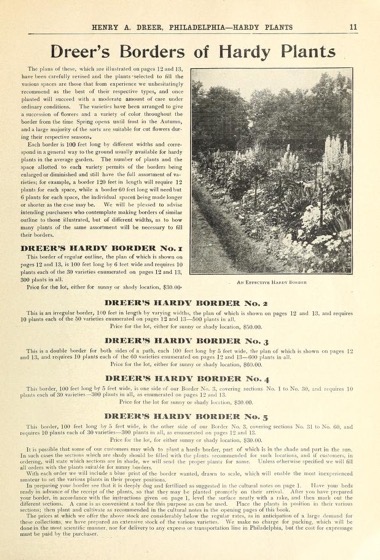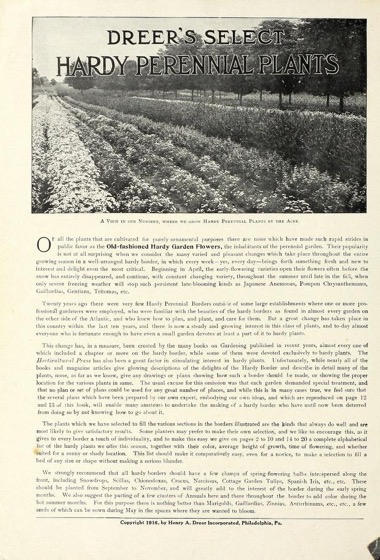Historical Seed Catalogs – 91 in a series – Dreer’s old-fashioned hardy plants (1916)
Download in Text, PDF, Single Page JPG, Torrent from Archive.org
Of all the plants tliat are cultivated for purely ornamental purposes there are none which have made such rajiid strides in public favor as the Old=fashioned Hardy Garden Flowers, the inhabitants of the perennial garden. Their popularity is not at all surprising wlien we consider the many varied and pleasant changes which take place throughout the entire growing season in a well-arranged hardy border, in which every week — yes, every day — brings forth something fresh and new to interest and delight even the most critical. Beginning in April, the early-flowering varieties open their flowers often before the snow has entirely disappeared, and continue, with constant changing variety, throughout the summer until late in the fall, when only severe freezing weather will stop such persistent late-blooming kinds as Japanese Anemones, Pompon Chrysanthemums, Gaillardias, Gentians, Tritomas, etc.
Twenty years ago there wert very few Hardy Perennial Borders outside of some large establishments where one or more pro- fessional gardeners were employed, who were familiar with the beauties of the hardy borders as found in almost every garden on the other side of the Atlantic, and who knew how to plan, and plant, and care for them. But a great change has taken place in this country within the last ten years, and there is now a steady and growing interest in this class of plants, and to-day almost everyone who is fortunate enough to have even a small garden devotes at least a part of it to hardy plants.
This change has, in a measure, been created by the many books on Gardening published in recent years, almost every one of which included a chapter or more on the hardy border, while some of them were devoted exclusively to hardy plants. The HorticiiUwrnl Press has also been a great factor in stimulating interest in hardy plants. Unfortunately, while nearly all of the books and magazine articles give glowing descriptions of the delights of the Hardy Border and describe in detail many of the plants, none, as far as we know, give any drawings or plans showing how such a border should be made, or showing the proper location for the various plants in same. The usual excuse for this omission was that each garden demanded special treatment, and that no plan or set of plans could be used for any great number of places, and while this is in many cases true, we feel sure that the several plans which have been prepared by our own expert, embodying our own ideas, and which are reproduced on page 12 and 13 of this book, will enal)le many amateurs to undertake the making of a hardy border who have until now been deterred from doing so by not knowing how to go about it. The plants which we have selected to fill the various sections in the borders illustrated are the kinds that always do well and are most likely to give satisfactory results. Some planters may prefer to make their own selection, and we like to encourage this, as it gives to every border a touch of individuality, and to make this easy we give on pages 2 to 10 and 14 to 20 a complete alphabetical list of the hardy plants we offer this season, together with their color, average height of growth, time of flowering, and whether “ffeuited for a sunny or shady location. This list should make it comparatively easy, even for a novice, to make a selection to fill a bed of any size or shape without making a serious blunder.
We strongly recommend that all hardy borders should have a few clumps of spring-flowering bulbs inte/spersed along the front, including Snowdrops, Scillas, Chionodoxas, Crocus, Narcissus, Cottage Garden Tulips, Spanish Iris, etc., etc. These should be planted from September to November, and will greatly add to the interest of the border during the early spring months. We also suggest the putting of a few clusters of Annuals here and there throughout the border to add color during the hot summer months. For this purpose there is nothing better than Marigolds, Gaillardias, Zinnias, Antirrhinums, etc., etc., a few seeds of which can be sown during May in the spaces where they are wanted to bloom.
SEE MORE:
- Publication date 1916
- Topics Gardening Equipment and supplies Catalogs, Flowers Seeds Catalogs
- Publisher Philadelphia, Pa. : Henry A. Dreer
- Collection usda-nurseryandseedcatalog; usdanationalagriculturallibrary; fedlink; americana; biodiversity
- Digitizing sponsor U.S. Department of Agriculture, National Agricultural Library
- Contributor U.S. Department of Agriculture, National Agricultural Library
- Language English
- Volume 1916
* A portion of each sale from Amazon.com directly supports our blogs
** Many of these books may be available from your local library. Check it out!


